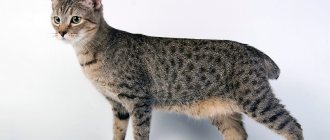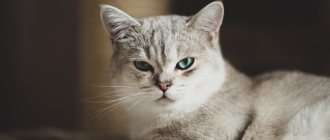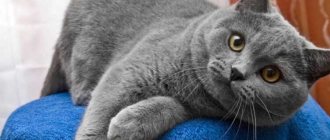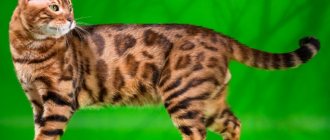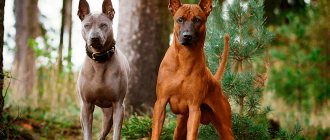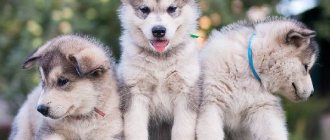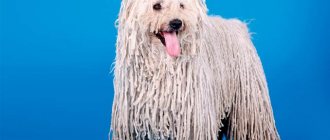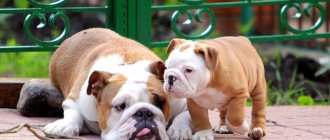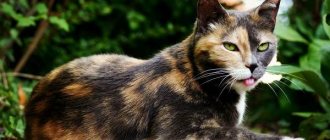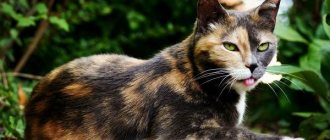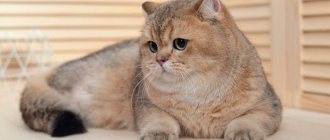Although many legends and traditions associated with cats have been preserved in the national Irish epic, this people never acquired their own breed. This is all due to the defeat of the independence fighters at the end of the 18th century, which ended with annexation to the British crown.
Along with the lands, local domestic animals also came under the rule of the empire. Since then, the term “Irish cat” has ceased to refer to one breed, but has become a collective image that combines several ancient breeds.
History in the chronicles and the actual origin of the Irish cat
10 centuries ago, Welsh laws determined not only the social structure of the territory of Wales, but even such little things as the cost of a domestic cat - 4 pence. At the same time, an age gradation was provided:
- from birth to the moment the eyes open, an Irish kitten cost 1 penny;
- after the first mouse killed, the price increased to 2d;
- As soon as an Irish cat became a full-fledged hunter, it was already valued at the full amount - 4 pence.
The Irish also added a cat to the list of things necessary for every housewife.
If someone's cat was killed by an Englishman, he was obliged to compensate for the damage with a lamb or an adult sheep. Sometimes they paid in grain - a pile of wheat had to cover the entire length of an Irish cat. But the presence of a domestic rat catcher at a housewarming party, unlike Russian tradition, was not allowed.
The patron saint of Irish cats was Saint Patrick himself, but this did not save the local breed from extinction. As soon as power passed to Britain, the history of a separate species ended, and a new page in the cat's pedigree opened.
Description of the British
A century and a half ago, the British Isles were considered the world felinological center. Exotic cats came here along with the military and merchants from the East. It was during this period that the crossing of local animals with those brought on ships from distant countries began.
Thus, the Irish cat breed completely merged with the new English population.
The ancestors of ordinary British cats came to the islands with the Roman conquerors. It is believed that these were representatives of the Egyptian cat breed, but there is no factual evidence of this.
In England, they adapted to new climatic conditions, acquired thick hair and established family relationships with local four-legged rat catchers, among which a branch of Irish cats was already represented.
This is how a group of British cats was formed, which was later recognized as an aboriginal breed with certain external characteristics:
- Stocky animals with a harmonious physique.
- Gray-blue color, traditional for the British breed.
- All the lines of the body and head of the British are smooth - even the tail ends in a slight curve.
- The ears are set wide, forming an equilateral triangle between their bases and the nose.
- Round cheeks.
- Low legs with round, powerful paws.
- The most common eye color is honey-amber, but green, blue and even lavender are also acceptable.
The descendants of Irish cats are distinguished by good health. They often live to an old age (20 years), and do not suffer from chronic diseases.
Who is a forest cat
The wild forest cat, otherwise called the European cat, belongs to the cat family and is recognized as a wild mammal. According to researchers, it originated from domesticated forest cats about 10 thousand years ago. This happened in the Middle East. Storing crops grown here attracted rodents. And wild cats also decided to hunt for such a “delicacy”. The closest relative of the forest animal is the sand cat.
The closest relative of the forest cat is the sand cat.
Over the past few decades, the population has declined sharply. On the territory of the Russian Federation, animals are kept in nature reserves, as they belong to a rare species. The main threat to the population is the reduction of forests. The number of species is also related to the number of main prey - rodents. The highest population density is 20–30 individuals per 1 sq. m. The cat is listed in the CITES Convention (Appendix II), as well as in the Red Book.
Description of Scottish Fold cats
In 1961, in Scotland, not far from the town of Cupar Angus, an unusual white cat appeared. The only distinguishing feature from the traditional British breed was its ears. Their tips curved forward, which gave the round muzzle an unusual appearance.
Later, Susie's cat gave birth to kittens, two of which inherited an external genetic change. One of them was sterilized, and the second was purchased by farmer William Ross, a big cat lover. Together with geneticist Pat Turner, they developed a new breed of fold-eared animals.
Scientists have found that the mutation was caused by an ordinary dominant gene that does not affect the health of the offspring. Subsequently, all work with the breed was transferred to the USA, where the Scottish Fold breed was crossed with British and American shorthair cats.
Scottish Fold descendants of Irish cats differ from the British breed in the following external characteristics:
Appearance and features
Photo: What a forest cat looks like
In appearance, a wild cat can be easily confused with a short-haired pet. These are small animals, reaching no more than 7 kilograms in adulthood. The length of males reaches about 90 centimeters, females - no more than 75-80. They are distinguished from ordinary cats only by their slightly shortened paws and tail (at the same time, due to their characteristics, some specially bred breeds are practically indistinguishable from forest ones).
Video: Forest cat
A distinctive characteristic of wild individuals of the feline class is their rounded muzzle. She is special with her round eyes and erect triangular shaped ears. The mouth of cats is also unusual. Her teeth are smaller (than those of ordinary cats), but much sharper.
The animals' fur is short but thick. There are individuals of almost all shades of gray (dark, light, reddish). On the fur of most wild felines, transverse stripes are clearly visible, running along the entire body and tail (where they become especially clear). Molting occurs twice a year. On the tail the hair is much thicker and slightly longer. The tassels characteristic of some feline predators are absent. The paws of the animals are equipped with sharp retractable claws, which are the main weapon.
Character and temperament of the Irish cat
Representatives of the British breed are independent, do not like to be held and do not suffer from loneliness if the owner is away from home for a long time. All this cat needs is food and water.
Sometimes owners share observations about their Britons and note their extraordinary ability to sleep 20 hours a day. Traditional English cats also tend to show aggression.
The Scots differ from them in temperament and character:
- they are affectionate and sociable;
- take part in games with pleasure;
- get along well with other pets.
Feeding an Irish cat
All English breeds are prone to overeating, especially in the second half of life. Therefore, the owner must strictly control the volume of portions and monitor the pet’s physical activity.
The diet for Irish cats depends on the age of the animal:
The difficult nature of the British does not manifest itself in their pickiness about food. They have a normal attitude towards all products and do not require any “aristocratic” delights for themselves.
Education and physical activity
Features of raising and keeping a cat directly depend on the nature of the breed:
The process of raising a Briton cannot be interrupted for a minute. Otherwise, this wayward cat will quickly imagine itself as the head of the family and begin to establish its own rules. By the way, the Briton willingly uses both teeth and claws.
The Scottish Fold is the exact opposite of the British cat breed. We can say that his delicacy knows no bounds. He can do something contrary to his beloved owner only in one case - from pain.
Life in captivity
Since the wild forest cat is listed in the Red Book, its purchase and sale is illegal. Consequently, in captivity this wild cat can only be found in a zoo or nature reserve.
Conditions of detention
This exotic pet loves space, so it is better to keep it in a small fenced area or by setting up an enclosure. At the same time, you need to remember that the animal jumps 3 meters in length, so it is better to make the fence a little higher. The enclosure must have trees or logs for the pet to climb, as it did in the wild. In a zoo, the conditions for keeping an animal should be the same.
Of course, in a reserve, where an animal feels like in the wild, it lives better than in a zoo.
In captivity, cats reproduce well. Thanks to their maintenance in nature reserves and zoos, the population is preserved.
A forest cat's enclosure should contain trees or logs that it is used to climbing in the wild.
Caring for such a pet is not difficult - it is enough to comb the animal’s fur weekly and bathe it monthly (but this should not be done often). The wild forest cat does not like change, so “his things” do not need to be swapped. These animals are quite strong physically, but they still need to be visited by a veterinarian every six months, who will help eliminate the following diseases characteristic of the breed:
- hypertrophic cardiomyopathy (heart disease);
- polycystic kidney disease;
- retinal dysplasia.
It is not recommended to castrate or sterilize a wild pet, as it does not tolerate anesthesia well.
A friend of mine constantly sends photographs of her wild forest cat, since she lives far away and I have no opportunity to see the animal. A friend says that her pet’s character is not very flexible, but she attributes this feature to the animal’s wild nature. The girl says that, on the contrary, this suits her. A friend of hers bathes her pet quite rarely, and practically doesn’t care about its appearance at all, which is very convenient for her, since she, one might say, “lives” at work. And the cat, although with character, misses her, but lately he has become accustomed to this routine. The main problem is feeding the purr - my friend chose natural food for him, which has to be prepared in advance. Usually this takes up a decent part of the weekend, which, of course, makes the girl indignant. However, according to her, it’s worth it, because a real predator lives next to her. A friend arranged a special house for the animal, reminiscent of a small enclosure. Sometimes she lets the cat out for a walk around the outskirts of her property, but she is very afraid that the wild nature will overpower her love for her owner, and the pet will run away.
